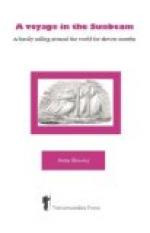The first part of our way lay along the flat ground, gay with bright scarlet Guernsey lilies, and shaded by cocoa-nut trees, between the town and the sea. Then we struck off to the right, and soon left the town behind us, emerging into the open country. At a distance from the sea, Hilo looks as green as the Emerald Isle itself; but on a closer inspection the grass turns out to be coarse and dry, and many of the trees look scrubby and half dead. Except in the ‘gulches’ and the deep holes between the hills, the island is covered with lava, in many places of so recent a deposit that it has not yet had time to decompose, and there is consequently only a thin layer of soil on its surface. This soil being, however, very rich, vegetation flourishes luxuriantly for a time; but as soon as the roots have penetrated a certain depth, and have come into contact with the lava, the trees wither up and perish, like the seed that fell on stony ground.
The ohia trees form a handsome feature in the landscape, with their thick tall stems, glossy foliage, and light crimson flowers. The fruit is a small pink waxy-looking apple, slightly acid, pleasant to the taste when you are thirsty. The candle-nut trees attain to a large size, and their light green foliage and white flowers have a very graceful appearance. Most of the foliage, however, is spoiled by a deposit of black dust, not unlike what one sees on the leaves in a London garden. I do not know whether this is caused by the fumes of the not far-distant volcano, or whether it is some kind of mould or fungus.
After riding about ten miles in the blazing sun we reached a forest, where the vegetation was quite tropical, though not so varied in its beauties as that of Brazil, or of the still more lovely South Sea Islands. There were ferns of various descriptions in the forest, and many fine trees, entwined, supported, or suffocated by numerous climbing plants, amongst which were blue and lilac convolvulus, and magnificent passion-flowers. The protection from the sun afforded by this dense mass of foliage was extremely grateful; but the air of the forest was close and stifling, and at the end of five miles we were glad to emerge once more into the open. The rest of the way lay over the hard lava, through a sort of desert of scrubby vegetation, occasionally relieved by clumps of trees in hollows. More than once we had a fine view of the sea, stretching away into the far distance, though it was sometimes mistaken for the bright blue sky, until the surf could be seen breaking upon the black rocks, amid the encircling groves of cocoa-nut trees.
The sun shone fiercely at intervals, and the rain came down several times in torrents. The pace was slow, the road was dull and dreary, and many were the inquiries made for the ‘Half-way House,’ long before we reached it. We had still two miles farther to go, in the course of which we were drenched by a heavy shower. At last we came to a native house, crowded with people, where they were making tappa or kapa—the cloth made from the bark of the paper-mulberry. Here we stopped for a few minutes until our guide hurried us on, pointing out the church and the ‘Half-way House’ just ahead.




